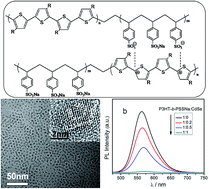Self-doped 3-hexylthiophene-b-sodium styrene sulfonate block copolymer: synthesis and its organization with CdSe quantum dots†
Abstract
A new self-doped 3-hexylthiophene-b-sodium styrene sulfonate block copolymer (P3HT-b-PSSNa) was obtained via solution copolymerization of sodium styrene sulfonate (SSNa) with vinyl end-group poly(3-hexylthiophene) (v-P3HT), which was synthesized under Grignard metathesis (GRIM) reaction conditions. The self-doping structure can be controlled by altering the feed amounts of SSNa monomer, and it exhibited tunable properties. In comparison with v-P3HT, P3HT-b-PSSNa shows good solubility, broad absorption, higher electrical conductivity and good donor/acceptor (D/A) interface binding with CdSe quantum dots (QDs). Composites of P3HT-b-PSSNa and CdSe exhibit uniform dispersion, good compatibility and highly efficient fluorescence quenching, and surface chemical state analysis confirmed the chemical bonding between copolymer and QDs. This is helpful for rapid charge transfer of different semiconductors in the two-phase D/A interface. Here, we developed a strategy for producing a conjugated polymer with both doped stability during repeated electric cycles and compatibility with inorganic semiconductor materials.


 Please wait while we load your content...
Please wait while we load your content...